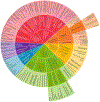An international classification of inherited metabolic disorders (ICIMD)
- PMID: 33340416
- PMCID: PMC9021760
- DOI: 10.1002/jimd.12348
An international classification of inherited metabolic disorders (ICIMD)
Abstract
Several initiatives at establishing a classification of inherited metabolic disorders have been published previously, some focusing on pathomechanisms, others on clinical manifestations, while yet another attempted a simplified approach of a comprehensive nosology. Some of these classifications suffered from shortcomings, such as lack of a mechanism for continuous update in light of a rapidly evolving field, or lack of widespread input from the metabolic community at large. Our classification-the International Classification of Inherited Metabolic Disorders, or International Classification of Inborn Metabolic Disorders (ICIMD)-includes 1450 disorders, and differs from prior approaches in that it benefited from input by a large number of experts in the field, and was endorsed by major metabolic societies around the globe. Several criteria such as pathway involvement and pathomechanisms were considered. The main purpose of the hierarchical, group-based approach of the ICIMD is an improved understanding of the interconnections between many individual conditions that may share functional, clinical, and diagnostic features. The ICIMD aims to include any primary genetic condition in which alteration of a biochemical pathway is intrinsic to specific biochemical, clinical, and/or pathophysiological features. As new disorders are discovered, we will seek the opinion of experts in the advisory board prior to inclusion in the appropriate group of the ICIMD, thus guaranteeing the continuing relevance of this classification via regular curation and expert advice.
Keywords: ICIMD; classification; inherited metabolic disorders; ontology.
© 2021 Commonwealth of Australia. Journal of Inherited Metabolic Disease © 2021 SSIEM. This article has been contributed to by US Government employees and their work is in the public domain in the USA.
Conflict of interest statement
Conflict of Interest:
Carlos Ferreira, Shamima Rahman and Johannes Zschocke declare that they have no conflict of interest.
Figures

References
MeSH terms
Grants and funding
LinkOut - more resources
Full Text Sources
Other Literature Sources
Research Materials

